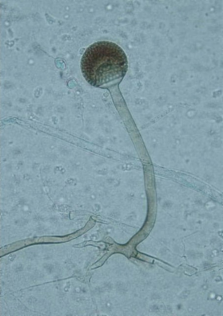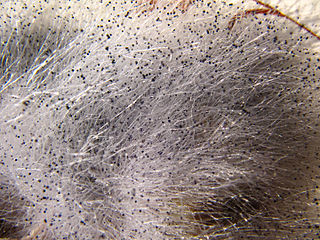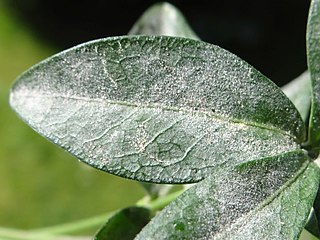
Metalaxyl is an acylalanine fungicide with systemic function. Its chemical name is methyl N-(methoxyacetyl)-N-(2,6-xylyl)-DL-alaninate. It can be used to control Pythium in a number of vegetable crops, and Phytophthora in peas. Metalaxyl-M is the ISO common name and Ridomil Gold is the trade name for the optically pure (-) / D / R active stereoisomer, which is also known as mefenoxam.

Wheat leaf rust is a fungal disease that affects wheat, barley, rye stems, leaves and grains. In temperate zones it is destructive on winter wheat because the pathogen overwinters. Infections can lead up to 20% yield loss. The pathogen is a Puccinia rust fungus. It is the most prevalent of all the wheat rust diseases, occurring in most wheat-growing regions. It causes serious epidemics in North America, Mexico and South America and is a devastating seasonal disease in India. P. triticina is heteroecious, requiring two distinct hosts.

Erysiphales are an order of ascomycete fungi. The order contains one family, Erysiphaceae. Many of them cause plant diseases called powdery mildew.

Phomopsis cane and leaf spot occurs wherever grapes are grown. Phomopsis cane and leaf spot is more severe in grape-growing regions characterized by a humid temperate climate through the growing season. Crop losses up to 30% have been reported to be caused by Phomopsis cane and leaf spot.

Ug99 is a lineage of wheat stem rust, which is present in wheat fields in several countries in Africa and the Middle East and is predicted to spread rapidly through these regions and possibly further afield, potentially causing a wheat production disaster that would affect food security worldwide. In 2005 the noted green revolution pioneer Norman Borlaug brought great attention to the problem, and most subsequent efforts can be traced to his advocacy. It can cause up to 100% crop losses and is virulent against many resistance genes which have previously protected wheat against stem rust.
Glomerella graminicola is an economically important crop parasite affecting both wheat and maize where it causes the plant disease Anthracnose Leaf Blight.

Rhizopus microsporus is a fungal plant pathogen infecting maize, sunflower, and rice.

Didymella bryoniae, syn. Mycosphaerella melonis, is an ascomycete fungal plant pathogen that causes gummy stem blight on the family Cucurbitaceae, which includes cantaloupe, cucumber, muskmelon and watermelon plants. The anamorph/asexual stage for this fungus is called Phoma cucurbitacearum. When this pathogen infects the fruit of cucurbits it is called black rot.
Nigrospora sphaerica is an airborne filamentous fungus in the phylum Ascomycota. It is found in soil, air, and plants as a leaf pathogen. It can occur as an endophyte where it produces antiviral and antifungal secondary metabolites. Sporulation of N. sphaerica causes its initial white coloured colonies to rapidly turn black. N. sphaerica is often confused with the closely related species N. oryzae due to their morphological similarities.

Puccinia thaliae is the causal agent of canna rust, a fungal disease of Canna. Symptoms include yellow to tan spots on the plant's leaves and stems. Initial disease symptoms will result in scattered sori, eventually covering the entirety of the leaf with coalescing postulates. Both leaf surfaces, although more predominant on the underside (abaxial) of the leaf, will show yellow to brownish spore-producing these pustulate structures, and these are the signs of the disease. Spots on the upper leaf-surface coalesce and turn to brown-to-black as the disease progresses. Infection spots will become necrotic with time, with small holes developing in older leaves. These infected leaves eventually become dry and prematurely fall.

Rhizopus stolonifer is commonly known as black bread mold. It is a member of Zygomycota and considered the most important species in the genus Rhizopus. It is one of the most common fungi in the world and has a global distribution although it is most commonly found in tropical and subtropical regions. It is a common agent of decomposition of stored foods. Like other members of the genus Rhizopus, R. stolonifer grows rapidly, mostly in indoor environments.
Cranberry fruit rot (CFR) is a disease complex of multiple fungal agents affecting the American cranberry. Cranberry fruit rot can be categorized into field rot and storage rot. The importance of field rot and fruit rot depends on how the cranberries will be processed after harvest. If cranberries are immediately processed after harvest, growers focus on preventing field rot while with fresh market cranberries, growers seek to prevent storage rot. There are 10-15 fungal pathogens known to cause cranberry fruit rot diseases, some active in only field rot, storage rot, or both. The majority of these fungal pathogens are ascomycetes, with the rest being deuteromycetes. There is no known bacterial pathogen that plays a role in CFR or any major disease on cranberry, potentially due to the low pH conditions on the cranberry fruit.

Pyraclostrobin is a quinone outside inhibitor (QoI)-type fungicide used in agriculture. Among the QoIs, it lies within the strobilurin chemical class.

Colletotrichum fioriniae is a fungal plant pathogen and endophyte of fruits and foliage of many broadleaved plants worldwide. It causes diseases on agriculturally important crops, including anthracnose of strawberry, ripe rot of grapes, bitter rot of apple, anthracnose of peach, and anthracnose of blueberry. Its ecological role in the natural environment is less well understood, other than it is a common leaf endophyte of many temperate trees and shrubs and in some cases may function as an entomopathogen.

Bitter rot of apple is a fungal disease of apple fruit that is caused by several species in the Colletotrichum acutatum and Colletotrichum gloeosporioides species complexes. It is identified by sunken circular lesions with conical intrusions into the apple flesh that appear V-shaped when the apple is cut in half through the center of the lesion. It is one of the most devastating diseases of apple fruit in regions with warm wet weather.

Golovinomyces orontii is a species of fungus that causes powdery mildew disease and it is in the family Erysiphaceae. It is an obligate biotroph that infects plants in several families including Acanthaceae, Asteraceae, Brassicaceae, Cucurbitaceae, and Lamiaceae.












